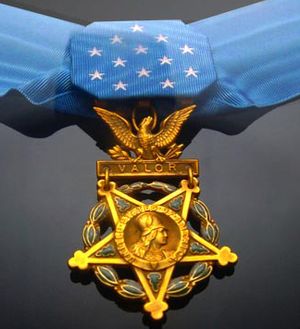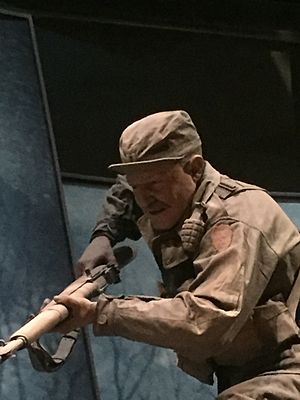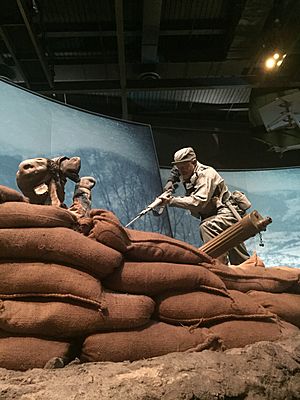Lewis Millett facts for kids
Quick facts for kids
Lewis L. Millett
|
|
|---|---|

Millett in 1985
|
|
| Birth name | Lewis Lee Millett |
| Born | December 15, 1920 Mechanic Falls, Maine, U.S. |
| Died | November 14, 2009 (aged 88) Loma Linda, California, U.S. |
| Buried |
Riverside National Cemetery
|
| Allegiance | United States Canada |
| Branch |
|
| Service years |
|
| Rank | Colonel |
| Units |
|
| Wars | |
| Awards |
|
Lewis Lee Millett Sr. (born December 15, 1920 – died November 14, 2009) was a brave officer in the United States Army. He earned the highest military award, the Medal of Honor, during the Korean War. He received it for leading the last big American bayonet charge.
Millett joined the U.S. National Guard while still in high school. In 1940, he joined the U.S. Army Air Corps. Thinking the United States would not join World War II, he left his post and went to Canada. There, he joined the Canadian Army and was sent to London. He served briefly with the Canadian forces. Soon after, he transferred to the U.S. Army, which had now joined the war. During World War II, he earned a Silver Star. He got it for driving a burning truck full of ammunition away from soldiers before it exploded.
During the Korean War, he received the Medal of Honor. This award is the highest honor in the U.S. military. He earned it for bravely leading a bayonet charge against the enemy. He later served in the Vietnam War. Millett retired from the Army in 1973. He passed away in 2009 from heart problems.
Contents
Early Life and Joining the Military
Millett was born on December 15, 1920, in Mechanic Falls, Maine. He grew up in South Dartmouth, Massachusetts. His parents divorced, and his mother remarried, moving them there. His family had a history of military service. His grandfather fought in the American Civil War. An uncle fought in World War I with the Massachusetts Army National Guard.
While still in high school in Dartmouth, Lewis Millett joined the Massachusetts National Guard in 1938. He joined his uncle's old group, the 101st Field Artillery. In 1940, he joined the United States Army Air Corps. He then went to gunnery school.
Fighting in World War II
In mid-1941, it seemed like the U.S. might not enter World War II. Millett really wanted to fight. He left his post without permission. With a friend, Millett traveled to Canada. There, he joined the Canadian Army. He was sent to the United Kingdom. He worked as an anti-aircraft radar operator in London during the Blitz. This was a time when Germany bombed London.
Once the U.S. joined the war, Millett transferred to the U.S. Army in 1942. He was assigned to the 27th Armored Field Artillery Regiment. This was part of the 1st Armored Division. Millett served in Tunisia as an anti-tank gunner. This was during Operation Torch. During one battle, he drove a burning half-track (a type of military vehicle) filled with ammunition away from Allied soldiers. He jumped out just before it blew up. For this brave act, he received the Silver Star. This is the third-highest U.S. military award. He also shot down a German Messerschmitt Bf 109 fighter plane. He used machine guns mounted on his half-track.
Millett, who was a sergeant by then, next fought in the Allied invasion of Italy. He was part of the Battle of Salerno and the Battle of Anzio. Around this time, the U.S. Army found out about Millett leaving his post in 1941. He faced a military court. He was ordered to pay a fine and lost his leave time. Just weeks later, he was made a second lieutenant on the battlefield.
Korean War Heroics
After World War II, Millett went to Bates College for three years. Then, he was called to serve in the Korean War.
On December 5, 1950, Captain Millett was flying as an observer. Another pilot, Captain J.F.O. Davis, crash-landed his plane in North Korea. Millett's pilot landed near the crashed plane. Millett gave up his seat so Captain Davis could be rescued. This was very brave because enemy troops were all around. Millett was later found and picked up before dark.
By February 7, 1951, Millett was a captain in South Korea. He commanded Company E of the 2nd Battalion, 27th Infantry Regiment. On that day, near Soam-Ni, he led his company in an attack. They were assaulting an enemy position on top of Hill 180. When one group of soldiers got stuck under heavy fire, Millett took another group forward. He joined the two groups and led them up the hill. He used his bayonet and threw hand grenades. Millett shouted encouragement to his soldiers during the close-up fight. When they reached the top of the hill, his men attacked the enemy position. They forced the enemy soldiers to leave. Millett was wounded in the leg by grenade pieces. But he refused to leave until the position was safe.
A historian named S.L.A. Marshall said this attack was "the most complete bayonet charge by American troops" in a long time. About 20 of the 50 enemy soldiers who died were killed by bayonets. The place later became known as Bayonet Hill.
For his leadership during this attack, Millett received the Medal of Honor. President Harry S Truman officially gave him the medal in July 1951.
Service in Vietnam and Retirement
After the Korean War, Millett went to Ranger School at Fort Benning, Georgia. He served in the 101st Airborne Division as an intelligence officer. Later, he served in the Vietnam War. He was a military advisor for the Phoenix Program. This program aimed to find and stop enemy supporters. In 1959, he commanded the first "Recondo" school. This school trained soldiers in small unit tactics and patrolling skills. In the mid-1960s, he commanded a training center at Fort Devens, Massachusetts. In 1963, he earned a college degree in political science.
Millett retired from the military in 1973. He was a colonel when he retired. He later said he retired because he felt the U.S. had "quit" in Vietnam.
Later Years and Family Life
After his military career, Millett worked as a deputy sheriff in Trenton, Tennessee. He eventually moved to Idyllwild, California. He lived there for the rest of his life. He often attended events celebrating veterans. He was a member of the Congressional Medal of Honor Society.
Millett's first marriage ended in divorce. In 1951, when he received his Medal of Honor, he met Winona Williams. They later married and had four children: Lewis Lee Jr., Timothy, John, and Elizabeth. They were married for over 40 years until Winona Millett passed away in 1993. Millett's son John was an Army staff sergeant. He was one of over 240 U.S. military members killed in 1985. Their airplane, Arrow Air Flight 1285, crashed in Gander, Newfoundland. They were returning home from peacekeeping duty.
Millett died on November 14, 2009, from heart problems. He was almost 89 years old. He passed away at a medical center in Loma Linda, California. He had been in the hospital for four days. He had several health issues in his last years, including diabetes. His funeral was held on December 5, 2009, at Riverside National Cemetery in Riverside, California.
Awards and Special Recognitions
Millett received many military awards. These include the Medal of Honor, the Distinguished Service Cross, the Silver Star, three Legions of Merit, three Bronze Star Medals, four Purple Hearts, and two Air Medals.
Other U.S. military awards include the Combat Infantryman Badge, Ranger Tab, Good Conduct Medal, American Defense Service Medal, American Campaign Medal, European-African-Middle Eastern Campaign Medal, World War II Victory Medal, Army of Occupation Medal, National Defense Service Medal, Korean Service Medal, Armed Forces Expeditionary Medal and the Vietnam Service Medal.
His international military awards include the Canadian Volunteer Service Medal, the Canadian Victory Medal, the Vietnam Cross of Gallantry, the Croix de Guerre, the United Nations Korea Medal, and the Republic of Vietnam Campaign Medal.
Other Honors and Memorials
At Osan Air Base in South Korea, a road called "Millett Road" is named after Colonel Millett. It goes up Hill 180. This is where the Battle of Bayonet Hill / Hill 180 Memorial is located. An annual ceremony is held here to remember the battle. This hill was once thought to be where he led the famous bayonet charge. Later research showed the battle was actually north of Suwon, near Anyang.
In 1999, Millett received a Golden Palm Star. It was placed on the Palm Springs Walk of Stars for Veterans Day. This recognized him as one of five Medal of Honor recipients from that area.
In 2009, a park in San Jacinto, California, was named in honor of Millett.
At the US Army Infantry Museum at Fort Benning, Georgia, there is a life-size display. It shows Millett's bayonet charge up Hill 180 during the Korean War. Millett is clearly shown leading the charge.
See also
- List of Korean War Medal of Honor recipients
- List of Bates College people




